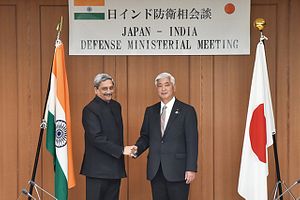Indian Defense Minister Manohar Parrikar and his Japanese counterpart, Gen Nakatani, issued a joint statement on the recent South China Sea ruling at the conclusion of the annual Indo-Japanese Defense Ministerial Meeting on July 14. In the statement, both Parrikar and Nakatani asked parties involved in the territorial disputes to “show utmost respect” for the UN Convention on the Law of the Sea (UNCLOS). The language of the document closely resembles seperate statements issued by the Indian Ministry of External Affairs and Japanese Ministry of Foreign Affairs on July 12.
“The Ministers recognized that the security and stability of the Seas connecting the Indian and Pacific Oceans are indispensable for the peace and prosperity of the Indo-Pacific region. The Ministers expressed concern over recent developments in this regard,” the statement reads. The ministers called for all parties to work toward a peaceful settlement of the disputes “without any threat or use of force” and to ensure “freedom and safety of navigation and over-flight as well as unimpeded lawful commerce in international waters.” Parrikar and Nakatani also reiterated the importance of “respecting international law.”
India’s position on the South China Sea has been somewhat muddy. As The Diplomat reported previously, a April 2016 Russia-India-China trilateral statement called for all disputes in the South China Sea to “be addressed through negotiations and agreements between the parties concerned”—which closely resembles the language used by Chinese foreign ministry statements, as my colleague Ankit Panda pointed out.
According to some media reports, Gen Nakatani came to India specifically to urge the country to take a “meaningful position” on the South China Sea issue.
This is only the second time that a joint Indo-Japanese statement has mentioned the territorial disputes in the South China Sea. In December 2015, a joint statement by Indian Prime Minister Narendra Modi and Japanese Prime Minister Shinzo Abe called all parties to “avoid unilateral actions” in the South China Sea “that could lead to tensions in the region.” Neither statement specifically mentioned China.
During the Japanese defense minister’s three-day visit to India, both sides also agreed to explore setting up a Maritime Strategic Dialogue and possibly conduct a joint bilateral naval exercise. In 2015, Japan became a permanent member of the annual Malabar 2016 naval drill, originally a bilateral naval exercise between the United States and India
“Minister Nakatani expressed his appreciation for India’s decision for the participation of JMSDF in India-U.S. Malabar Exercises on a regular basis. The Ministers welcomed the successful Malabar exercise, held in June 2016 off the Japanese coast and decided to conduct India-U.S.-Japan Trilateral Joint Maritime Exercise Malabar in 2017,” the statement reads.
India and Japan also agreed to deepen their overall military cooperation including exchanging military personnel between the two countries.
However, despite an increased push more closer defense ties, there was no progress on a $1.3 billion defense deal over the procurement of 12 ShinMaywa US-2 amphibious search-and-rescue aircraft for the Indian Navy. “The Ministers commended the effort made by both countries regarding the cooperation on US-2 amphibious aircraft which was launched in 2013,” the joint statement merely states.

































